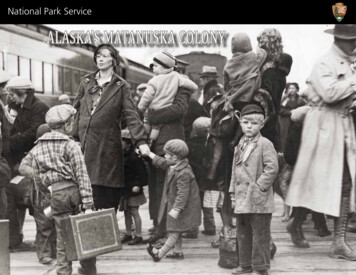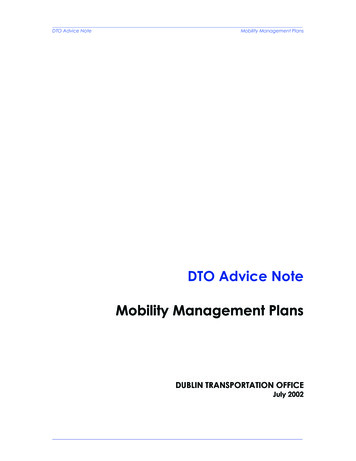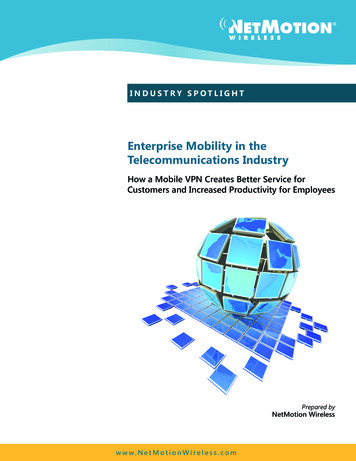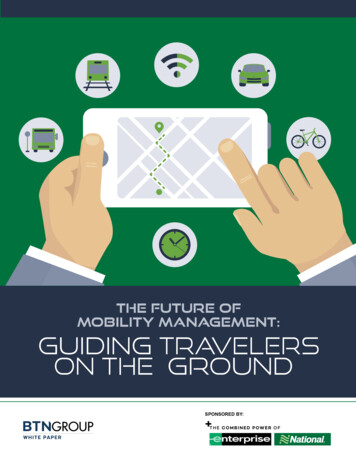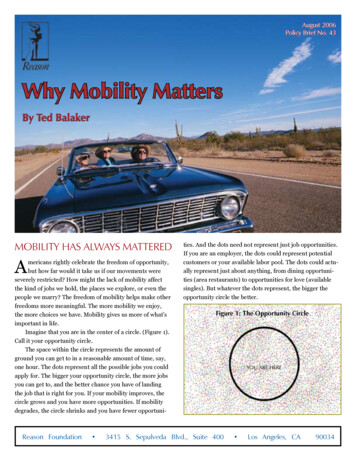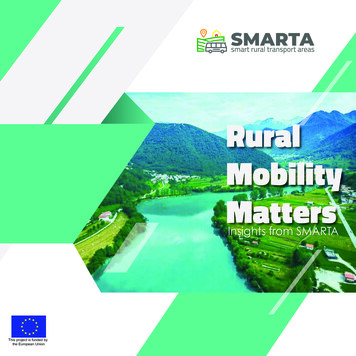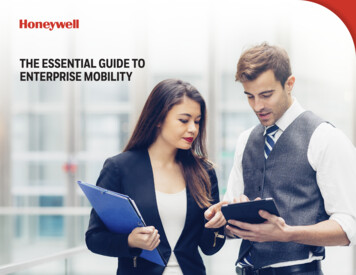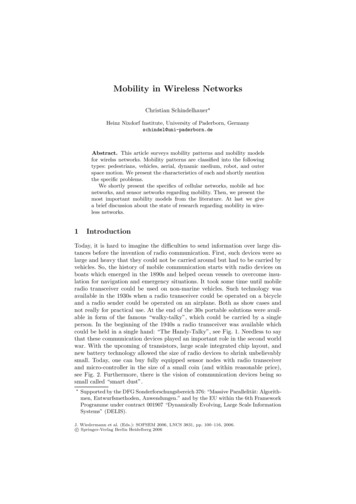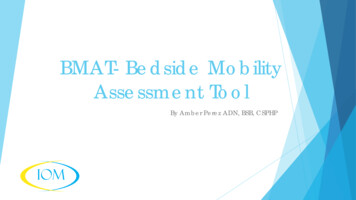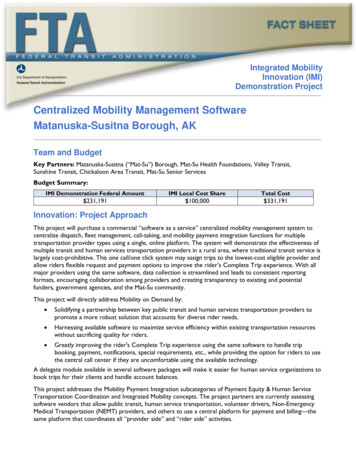
Transcription
Integrated MobilityInnovation (IMI)Demonstration ProjectCentralized Mobility Management SoftwareMatanuska-Susitna Borough, AKTeam and BudgetKey Partners: Matanuska-Susitna (“Mat-Su”) Borough, Mat-Su Health Foundations, Valley Transit,Sunshine Transit, Chickaloon Area Transit, Mat-Su Senior ServicesBudget Summary:IMI Demonstration Federal AmountIMI Local Cost ShareTotal Cost 231,191 100,000 331,191Innovation: Project ApproachThis project will purchase a commercial “software as a service” centralized mobility management system tocentralize dispatch, fleet management, call-taking, and mobility payment integration functions for multipletransportation provider types using a single, online platform. The system will demonstrate the effectiveness ofmultiple transit and human services transportation providers in a rural area, where traditional transit service islargely cost-prohibitive. This one call/one click system may assign trips to the lowest-cost eligible provider andallow riders flexible request and payment options to improve the rider’s Complete Trip experience. With allmajor providers using the same software, data collection is streamlined and leads to consistent reportingformats, encouraging collaboration among providers and creating transparency to existing and potentialfunders, government agencies, and the Mat-Su community.This project will directly address Mobility on Demand by: Solidifying a partnership between key public transit and human services transportation providers topromote a more robust solution that accounts for diverse rider needs. Harnessing available software to maximize service efficiency within existing transportation resourceswithout sacrificing quality for riders. Greatly improving the rider's Complete Trip experience using the same software to handle tripbooking, payment, notifications, special requirements, etc., while providing the option for riders to usethe central call center if they are uncomfortable using the available technology.A delegate module available in several software packages will make it easier for human service organizations tobook trips for their clients and handle account balances.This project addresses the Mobility Payment Integration subcategories of Payment Equity & Human ServiceTransportation Coordination and Integrated Mobility concepts. The project partners are currently assessingsoftware vendors that allow public transit, human service transportation, volunteer drivers, Non-EmergencyMedical Transportation (NEMT) providers, and others to use a central platform for payment and billing—thesame platform that coordinates all “provider side” and “rider side” activities.
Many current riders still pay with cash. The online payment system will provide another option; it will notreplace the cash option. Prospective software vendors will have the flexibility to incorporate available fundingto pay for rides or reimburse for trips. New providers would likely include cab companies, as TransportationNetwork Companies (TNCs) such as Uber or Lyft are not yet widely used in the Mat-Su Borough due to theregion’s low population density.Challenges Project is Designed To AddressFor local Mat-Su transportation providers, challenges stem primarily from the high cost of providing ruraltransit, the lack of consistent local government funding, a cumbersome Medicaid NEMT approval and billingprocess, and generally inadequate coordination between providers. For riders and organizations that representthem, challenges include high costs, limited service hours, and an outdated Medicaid NEMT system that lacksspeed and flexibility as well as insufficient knowledge of the range of available transportation services. The MatSu Borough Coordinated Human Services Transportation Plan 2018–2022 lists the following challenges: Funding concerns, with mixed funding sources, not enough options to acquire funding, and existingresources in a constant state of becoming depleted.Lack of financial support of public transit in Mat-Su Borough and affiliated cities.High costs to providers; public transit service providers must raise prices or cut services.Size of Mat-Su Borough and distance between people and services.Concern for transportation services that can adequately provide for the specialized needs of a givenorganization’s clients.Cumbersome Medicaid ride approval and billing process.Confusion regarding who to call for transportation and the range of transportation options (applies toboth providers and recipients).Providers working in “silos”; need for complementary services and coordination.Lack of education and marketing to create awareness of services.Ambulances overused for non-emergency medical transportation.Provider and rider ability/willingness to use new or existing services.Anticipated Outcomes, Benefits, and ImpactsThe primary outcomes of this project will be the creation of system-wide efficiency gains in the major publictransit and human service transportation providers in the Mat-Su Borough using the same software forscheduling, dispatch, fleet management, and payment management functions. Future marketing for the newsoftware will provide a single website and phone number for riders throughout the borough, allowing them toschedule a ride with the most cost-effective provider for their needs. The addition of system-wide efficiencieswill assist Mat-Su transit providers in building a stronger case for local government funding by showing a higherbenefit-cost ratio for future public funds spent on the system. The fleet management component of thesoftware will improve driver accountability and scheduling flexibility when issues arise (e.g., vehicle breakdown,traffic congestion).This project will improve service quality for riders. Transit users will benefit from a one-call/one-click systemthat handles all aspects of the trip, removing the challenge of having to learn contact information for multipleproviders. Riders, caregivers, delegates, case managers, etc., will benefit from a “one-stop shop” to managemultiple trips, detail special needs the provider must meet (e.g., wheelchair accessible vehicle, door-throughdoor service), and ensure that client accounts have sufficient funds.Implementing this project will improve system reliability. Using a web-based system hosted by the vendor willimprove network reliability, redundancy, data security and recoverability, and customer support. This transfersthe responsibility of data stewardship from the individual providers to an entity with a significantly highercapacity to manage data. Improved reliability will help potential riders see transit in the Mat-Su Borough as aviable mode of transportation to employment or any destination with a constrained time requirement(healthcare appointments, etc.).
Integrated Mobility Innovation (IMI)Demonstration ProjectBRATS On DemandBaldwin County, ALTeam and BudgetKey Partners: Baldwin County Commission/Baldwin Regional Area Transit System (BRATS), ViaTransportation, Inc.,Other Partners: Alabama Department of TransportationBudget Summary:IMI Demonstration Federal AmountIMI Local Cost ShareTotal Cost 260,800 65,200 326,000Innovation: Project ApproachThe past five years have seen significant gains in the research, innovation, and technology development forMobility on Demand (MOD) projects and best practices. Service in Baldwin County will take the lessonslearned from this work and move it forward by applying MOD to a new, rural setting, demonstrating it at alarger scale and operating multiple MOD services under a simpler and fully integrated platform.For rural areas, the service will expand standard on-demand offerings and practice by offering a service fullyscoped for rural mobility. Many communities around the US have already experienced the benefits of MOD,enabling them to easily plan, book, and pay for trips that meet their schedule through a consumer-facingmobile app. MOD has created better access to opportunity for these riders, enabling them to more easilycommute to work or school, run errands, and access healthcare more on their schedule.Although rural areas do represent an operational challenge for MOD service models, as trips are longer andriders are few and far between, these communities have just as much, if not more, to gain from reliable andaffordable access to mobility as do urban areas. BRATS On Demand will be the first MOD deployment in thenation designed specifically for rural mobility and the first to serve all trips for an entire transit network. It willtest the feasibility of everything from service design to business models, enabling communities and mobilityproviders around the country to better understand how they can apply MOD to their own particular needsand challenges.To date, MOD services have largely operated in a discreet section of a larger transit service area, providingcoverage to one or two neighborhoods or connections to transit stations. Through this project, BaldwinCounty will be the first transit agency in the nation to provide all of its services through MOD, either throughpre-scheduling or through an immediate, on-demand ride that will reach passengers in minutes. By eliminatingall fixed routes and schedules and converting service entirely to MOD, Baldwin County will demonstrate theimpact of a completely rider- and demand-driven transit network, where vehicles come only when they needto, cutting operational costs and increasing service efficiency throughout the county. As the first of its kind,Baldwin County will work closely with Via to ensure a fully-flexible service that improves over time inresponse to demand.
Challenges Project is Designed To AddressRural communities have largely been left out of the MOD conversation due to longer average trips, aperception that rural populations strongly favor personal vehicles, and business models that often rely onhigher population density to operate successfully. BRATS On Demand will address these challenges bydeploying a MOD model that accommodates long distance (interzone) trips through a pre-book option withinthe same mobile application, making public transit a convenient and efficient alternative to personal vehicles.Anticipated Outcomes, Benefits, and ImpactsThrough the BRATS On Demand project, Baldwin County and Via will validate the feasibility of rural MODbusiness models and document best practices emerging from the demonstration. The project will measure theimpact of MOD on rural communities to demonstrate the improved convenience and efficiency to passengersalong with a reduction of agency operational costs. The improved service will increase access for older adultsand individuals with limited personal mobility, allowing them to live longer, healthier, and happier lives inBaldwin County.Most importantly, BRATS On Demand will demonstrate that rural public transportation can be responsive tomodern trends for on-demand services, proving that public transit will continue to be both a relevant andprevalent aspect for mobility in rural communities.
Integrated Mobility Innovation (IMI)Demonstration ProjectDeveloping Standardized Payment Integration andInstitutional Capacity for Rural Mobility-as-a-ServiceSan Joaquin and Stanislaus Counties, CATeam and BudgetKey Partners: San Joaquin Regional Transit District (RTD), University of California-Davis, Trillium, Kyyti,InterlineBudget Summary:IMI Demonstration Federal AmountIMI Local Cost ShareTotal Cost 306,000 144,000 450,000Innovation: Project ApproachThe San Joaquin Regional Transit District (RTD) operates a variety of traditional and innovative transportationservices within San Joaquin County, an expansive service area covering 1,426 square miles and home to morethan 700,000 residents. RTD provides fixed-route and non-traditional services throughout the city of Stocktonand surrounding areas within San Joaquin County as well as commuter services to the Sacramento and SanFrancisco Bay areas.This project will enhance the regionwide (San Joaquin and Stanislaus counties) multimodal trip planning tool,Vamos, making it the mobility-as-a-service (MaaS) public transit platform for the region. All transit services willbe discoverable, and tickets will be purchasable in one app throughout the entire service area. Integrations willbe made through standards-based data transactions that develop a model to be used in other localities andprojects. After launch of the technologies early in the project, the focus of the demonstration will be onmarketing, communication, and user engagement and tracking those activities. The project will develop thebest strategies and tactics to support MaaS in smaller urban and rural areas.The project is a collaboration among regional and local transit providers, university researchers, proprietarysoftware-as-a-service vendors, open-source software developers, and data standards consultants. By sharinginfrastructure across agencies, agreeing on shared platforms and priorities, and focusing on building a lean,standards-based system with low maintenance costs, San Joaquin and Stanislaus counties are developing asustainable MaaS approach for other regions that face similar challenges. The practices and resourcesdeveloped for this project, as well as a toolbox of marketing approaches, will be shared widely to supportother regional efforts.Challenges Project is Designed To AddressMobile applications that support a MaaS model will provide a seamless user experience of picking up a mobiledevice, entering a destination, and seeing a clear and easy way to get travelers to their destination(s). MostMaaS business models are designed and developed by well-resourced agencies or corporations to provide thisexperience to an urban traveler with ample financial resources and no mobility restrictions. Unfortunately, thereality for clusters of smaller agencies with fewer resources is that available MaaS solutions are oftendisjointed, piecemeal, and frustrating to use. An equitable MaaS solution will serve those living outside of largerurban areas who have low incomes, and/or disabilities.
The long-term viability of mobile application supported MaaS is critically-dependent on adoption. The mobileapplication needs to be convenient and effectively marketed to public transit passengers. The proposed projectwill develop an equitable MaaS platform for San Joaquin and Stanislaus counties by augmenting a recentlylaunched app in two ways: (1) by integrating payment for fixed-route tickets with the current trip planner appand (2) by testing a series of marketing tactics to support adoption and rider-understanding. Both will bereplicable by mobile application developers and public transit providers. Marketing tactics will be evaluated anddocumented to allow more effective use of scarce marketing funds for public transportation agencies in thefuture.Anticipated Outcomes, Benefits, and ImpactsThe goal of the project is to provide a better understanding of the most effective strategies and tactics toincrease the adoption and use of MaaS in smaller urban and rural areas. The project will produce a report thatwill serve as a practical guide for agencies, regions, and businesses promoting multimodal trip planning andintegrated payment applications and services. These practices will include online, mobile, and social mediaadvertising, community outreach, and physical advertising and will be framed for use by public transit agenciesthat may not have access to large marketing budgets. The project will also provide open data and open sourcespecifications and documentation on how to integrate payment within an online or mobile trip planninginterface so transit agencies can deploy a cost-effective solution. An effective MaaS platform will ultimatelyimprove mobility for passengers who rely on public transit to travel within or between various modes oftransit and/or jurisdictional boundaries, with a convenient all-in-one tool.
Integrated Mobility Innovation (IMI)Demonstration ProjectOn-Demand Human Services Transportation forOlder Adults, People with Disabilities, andLow-Income Individuals in Boulder (“Via On-Demand”)Boulder, COTeam and BudgetKey Partners: City of Boulder, Via Mobility Services, University of Colorado BoulderOther Partners: National Renewable Energy Laboratory (NREL)Budget Summary:IMI Demonstration Federal AmountIMI Local Cost ShareTotal Cost 224,000 56,000 280,000Innovation: Project ApproachIn the US, the average cost for providing a one-way paratransit trip is about 47. Meanwhile, America’spopulation is aging, creating an increasing demand for human services transportation. If transit providers andlocal governments attempt to meet the rising demand, 47 for a paratransit trip is not sustainable. To addressthis conundrum, the City of Boulder, Via Mobility Services, and the University of Colorado Boulder willundertake a Mobility on Demand (MOD) pilot project, Via On-Demand, that will use autonomous, routeoptimization software to provide on-demand, wheelchair-accessible transportation to older adults, people withdisabilities, and individuals with lower incomes who live in Boulder. By using optimization software, the projectteam will test the extent to which increasing the number of shared trips and the average number of trips perhour can lower the average cost of a paratransit trip.Currently, there are several software development companies that have produced on-demand platforms forhuman transportation services that include innovations such as cloud-based advanced computing coupled withoptimization algorithms to continuously reorganize routes in real time, incorporating both scheduled trips, tripchanges, and on-demand trip requests. The project team will invite proposals from developers and choose theplatform that offers a high level of optimization, quality performance, affordable license fees, and meets otherrequirements.Challenges Project Is Designed To AddressThe project will focus on providing transportation that enhances the quality of life and functional capacity ofpersons with mobility limitations, including older adults, individuals with disabilities, and people with lowerincomes. Specifically, the project will be designed to support healthy aging and social integration as well asindependence and access to employment and training opportunities. The project will also provide humanservices transportation providers with performance-based metrics for implementing and evaluating on-demandservices such as energy efficiency, affordability, more productive use of assets, new revenues, higher customersatisfaction, lower wait times, and lower greenhouse gas emissions/environmental impacts.
Anticipated Outcomes, Benefits, and ImpactsThe project team anticipates that using on-demand, optimization routing software for human servicestransportation will result in efficiencies that reduce the average cost per trip while increasing mobility optionsand convenience for people with mobility limitations. With an aging population, it becomes increasinglyimportant for communities to support healthy aging, including addressing the problems of access to health careand the isolation experienced by older adults and people with disabilities. For persons with lower incomes,affordable and convenient mobility options are a means of increasing social equity in a transit system. All threeproject target populations will benefit from the independence and easy access to employment and trainingopportunities that MOD services provide.The project team and other human services transportation providers will benefit from the development ofperformance-based metrics for implementing on-demand software platforms and services. The metrics will alsobe applicable to on-demand public transit options developed to address first/last mile needs of the public,especially commuters. For these reasons, the results of the project will be published and data will be madeavailable to the public.
Integrated Mobility Innovation (IMI)Demonstration ProjectGHPIM Mobility PlatformGreater Hartford Transit District, CTTeam and BudgetKey Partners: Greater Hartford Transit District, M7Budget Summary:IMI Demonstration Federal AmountIMI Local Cost ShareTotal Cost 630,000 316,665 946,665Innovation: Project ApproachThe Greater Hartford Transit District intends to provide a new expansive, demand-responsive, 24/7transportation option to older adults and persons with disabilities that will fill many of the service gaps in theGreater Hartford Metropolitan Area and surrounding remote rural areas, while providing a Complete Tripexperience for all passengers. The service will be called the Greater Hartford Program for Innovative Mobility(GHPIM).To accomplish this, the District is partnering with Connecticut’s largest private transportation provider, M7,which has the smart technology to assist in providing a Complete Trip experience to riders and those noteligible for Americans with Disabilities (ADA) service. Eliminating the advance trip notification requirement andtravel boundaries are two key elements that will greatly improve the quality of life for qualified passengerswithin the District. This project will provide riders with the ease of booking a reservation and arrangingpayment through flexible technology options from the low-tech to the high-tech user. Riders will be able toschedule trips through a customer service toll-free number, web portal, and mobile app. It will address theprovision of the Complete Trip experience for older adults and persons with disabilities and will measureimpacts on the local community, providing broad access to mobility options for all travelers any time of daythroughout the year and to any destination in the specific project area.Challenges Project is Designed To AddressStatewide challenges reported in the Connecticut Locally Coordinated Human Services Transportation Planinclude the following: Service to/from smaller towns – fixed-route bus operators provide the most extensive service in areaswhere population densities support regularly-scheduled service. Inter/intra-regional transportation – the transportation services offered by smaller towns are focusedon the movement of citizens within the municipalities in which they reside. Weekday off-peak timeframes – Throughout the state, demand for both fixed-route and specializedtransportation service target groups is strongest during rush hour and midday. Weekends – Although all fixed-route bus providers operate service on one or both weekend days(except for Meriden), the level of service provided varies greatly by route.
Hartford Urbanized Area challenges for target populations include the following: Older adults noted the importance of available transportation as part of a continuum of care thatenables them to stay in their homes. Dial-a-ride users noted the inconvenience of needing to schedule ahead and of circuitous routing. The disabled community identified the need for inclusive public transportation that enablesindependence. More evening and weekend service on public transportation is needed.Anticipated Outcomes, Benefits, and ImpactsWith the new GHPIM program: Riders will be able to access information about the project faster. Links will be created between the District and its key partner, M7, through smart technology. Riders will experience a Complete Trip by being able to book and pay for a trip through their chosendevice, whether low-tech (telephone) or high-tech (mobile app). Gaps in service will be filled by M7’s ability to provide service 24 hours per day, 7 days per week, 365days per year. Riders will experience cost-effective and efficient mobility, improving their personal lives and providinga positive impact on the community. Publicizing the service will result in human service agencies referring customers, and unmet needs willbe met.A goal of the GHPIM project is to use paratransit resources in ways that serve more riders in a more efficientway while making the trip experience easy and convenient for customers.
Integrated Mobility Innovation (IMI)Demonstration ProjectAutomated Buses on CTfastrakCentral CTTeam and BudgetKey Partners: Center for Transportation and the Environment (CTE), New Flyer, Robotics Research,University of Connecticut (UCONN), Capital Region Council of Governments (CRCOG)Budget Summary:IMI Demonstration Federal AmountIMI Local Cost ShareTotal Cost 2,000,000 7,535,691 9,535,691Innovation: Project ApproachThe Connecticut Department of Transportation (CTDOT) and its assembled team will test automated busescapable of up to Level 4 automation on a dedicated right-of-way in Central Connecticut. The demonstrationwill deploy three 40-ft New Flyer Excelsior Charge battery electric buses equipped with automated drivingsystems (ADS) on the CTfastrak bus rapid transit (BRT) corridor, a dedicated nine-mile-long facility forexclusive use by CTtransit buses. Although the project will demonstrate technology capable of up to Level 4automation, the team will address IMI program objectives, namely Demonstration #1 in FTA’s Strategic TransitAutomation Research (STAR) Plan, by focusing on precision docking and bus platooning Level 2 automation.CTDOT is pursuing the integration of ADS on its CTfastrak buses as a unique innovation to 1) improveAmericans with Disabilities Act (ADA) accessibility at platforms through precision docking to eliminate drivererror that results in unsafe situations for passengers, 2) increase vehicle efficiency and capacity on theguideway through bus platooning, and 3) reduce the number of accidents resulting in injury or vehicle damageat two intersections along CTfastrak due to cross traffic not stopping at red lights. The project team will placeradar units in each direction at both crossings that will relay oncoming vehicle trajectories and speed viaDedicated Short Range Communications (DSRC).This project will allow CTDOT to test increasing levels of automation while in revenue service. The dedicatedguideway provides a controlled environment in which greater levels of automation can be tested at relativelyhigh speeds. The CTfastrak guideway is a controlled environment, as both pedestrians and non-CTDOTvehicles are prohibited.Challenges Project is Designed To AddressAlthough many cities have deployed low-speed automated vehicles (LSAV), no municipal or state agency hasinvested in automating high-capacity bus transit. Few transit bus services in the US operate on entirelyseparated guideways and can readily benefit from the degree of automation targeted in this CTfastrakdemonstration, and these advanced driver assistance systems (ADAS) are far closer to market-ready inaccordance with program requirements. When combined with a demonstration of vehicle-to-infrastructure(V2I) capabilities, this research can help accelerate the commercialization of these capabilities within the nextseveral years. CTDOT and its project partners are committed to putting the country’s first 40-ft automatedbuses into service at speeds up to 40 miles per hour and will do so in a compelling environment with hightransferability potential to other public transit agencies.
The project team believes that pursuing a Level 4 ADS automation suite of capabilities offers transit agencies abetter return on investment than the pursuit of individual, compartmentalized features. This project will allowCTDOT to test increasing levels of automation while in revenue service. The dedicated guideway provides acontrolled environment that prohibits cars and pedestrians such that greater levels of autonomy can be testedat high speed. Other demonstrations of autonomous shuttles have shown some success in mixed trafficenvironments, although they have been limited by drivers frequently taking over control of the buses whenthey do not fully trust the technology to respond appropriately in given situations. As drivers develop greatercomfort with the technology, they learn how it works and adapt.Unlike other closed testing grounds, the CTfastrak guideway transitions to a mixed traffic environment.Although the proposed project scope does not anticipate testing full autonomy in the mixed trafficenvironment, driver assistance features will remain active to improve vehicular safety. Currently, one of themost dangerous situations for a bus is when a pedestrian approaches it from the left; assistance features canalert the driver to the presence of the pedestrian and help them avoid collisions.Anticipated Outcomes, Benefits, and ImpactsThis project will add value as a demonstration of ADS technology in New England, which experiences all fourseasons. The CTfastrak guideway is maintained as a highway and remains in service even when other transitservices are shut down due to inclement weather. To date, all public sector automated vehicle pilots involvinglow-speed shuttles have shut down during snow events; the ADS technology demonstrated in this project willhave a greater tolerance for unfavorable conditions. ADS will be engaged in light rain or snow, althoughaccumulation of snow on sensors or heavier precipitation that greatly limits visibility will require drivers todisengage the system and operate the buses manually.Whereas relatively few transit agencies operate BRT service in partially or completely dedicated rights-of-way,these environments represent the most straightforward replicability for the capabilities demonstrated in thisproject. As the technology matures, agencies can introduce it into increasingly complicated operatingenvironments, progressing finally to all routes with mixed traffic. The lane-keeping, automated braking andacceleration, and precision docking features all offer value to transit operations today, even if implemented asdriver assistance features rather than an intended complete automation.Successful demonstrations of platooning would change the planning calculus between light rail and BRT.Agencies could provide similar capac
The Mat-Su Borough Coordinated Human Services Transportation Plan 2018-2022 lists the following challenges: Funding concerns, with mixed funding sources, not enough options to acquire funding, and existing resources in a constant state of becoming depleted. Lack of financial support of public transit in Mat-Su Borough and affiliated .
